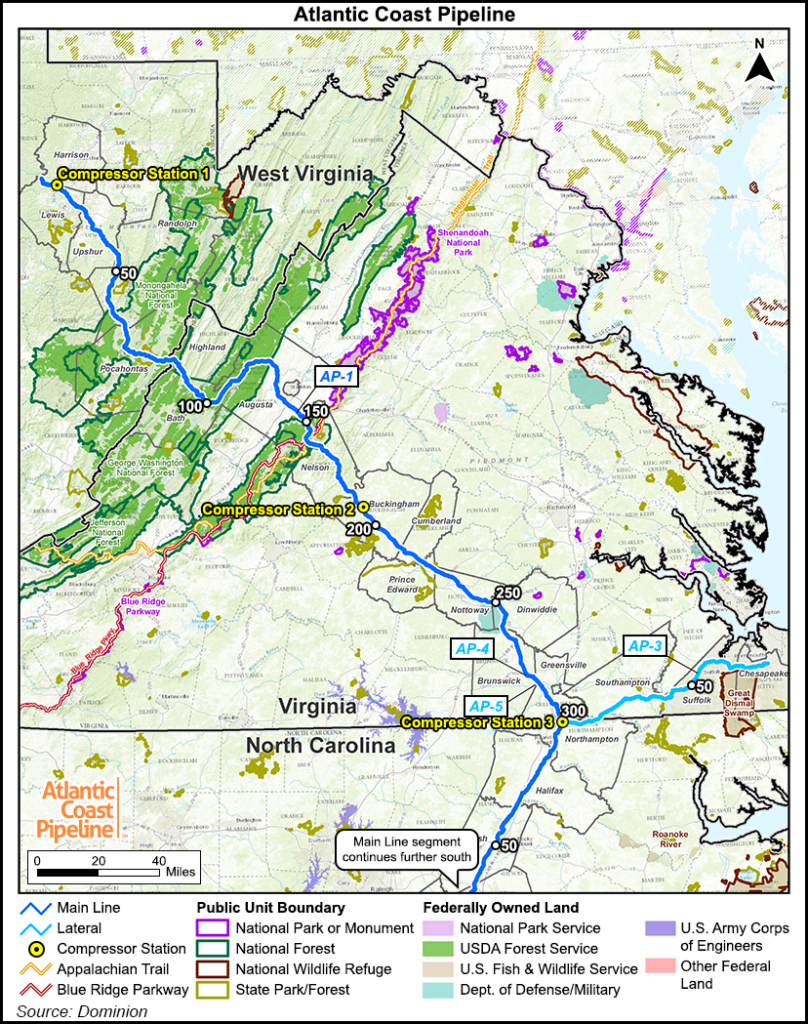Infrastructure | NGI All News Access | NGI The Weekly Gas Market Report | Regulatory
FERC Has Environmental Questions on Atlantic Coast Pipeline
FERC has asked Atlantic Coast Pipeline LLC (ACP) to provide additional information on its proposed natural gas pipeline within 20 days, after taking note of more than 100 items or inconsistencies that raised concerns with federal regulators.

The Federal Energy Regulatory Commission is preparing a final environmental impact statement (EIS) for the project [CP15-554], which would transport 1.5 Bcf/d of natural gas from the Marcellus and Utica shales to satisfy heating and electric generation demand in the Southeast.
In a 36-page letter to the pipeline’s backers — Dominion, Duke Energy and Southern Company Gas — FERC said it had identified seven geological areas of concern. Among them, it found numerous locations along the pipeline’s route that contain known and suspect closed depressions within the project’s current workspace. The locations were listed in an updated karst survey report filed last February.
“It appears that many of these features could be avoided by small route variations and/or potential workspace reductions,” FERC said, adding that ACP and Dominion should clarify whether they “propose to incorporate route and/or workspace design revisions to avoid or minimize impacts to these features.”
FERC’s letter came after the Commission received hundreds of comments regarding its draft EIS on the pipeline.
FERC also asked ACP and Dominion to describe the methods they used to identify orphan oil and natural gas wells along the pipeline route that are not incorporated into state databases in North Carolina, Virginia and West Virginia. The agency also asked how impacts to wells that may be encountered during construction would be minimized.
Among its concerns regarding water resources, federal regulators said a rare species report covering the George Washington National Forest (GWNF), filed last February, had identified 27 waterbodies that would be crossed by the pipeline — 25 of which would be affected by pipeline construction, and two by new permanent access roads.
But two subsequent reports contained different numbers. The first, a biological evaluation filed on March 10, said 30 waterbodies within the GWNF would be affected. A revised master waterbody table filed two weeks later listed 25 pipeline crossings and 12 access road crossings in the forest.
“Provide an updated waterbody crossing table that accurately addresses the inconsistencies,” FERC said. “Note that we will assume any updated waterbody table that is filed would replace waterbody crossing information presented in previously filed documents…”
Other concerns include temporary workspaces and impacts to vegetation, wildlife, fisheries, special status species, land use, special interest areas, and visual and cultural resources.
Last week, the U.S. Forest Servicetold FERC that a proposal to use horizontal directional drilling to bore the pipeline under the Appalachian Trail and the Blue Ridge Parkway was feasible. But the U.S. Environmental Protection Agency and the Department of Interior recommended that FERC conduct further analysis before releasing its final EIS.
© 2024 Natural Gas Intelligence. All rights reserved.
ISSN © 1532-1231 | ISSN © 2577-9877 | ISSN © 1532-1266 |
